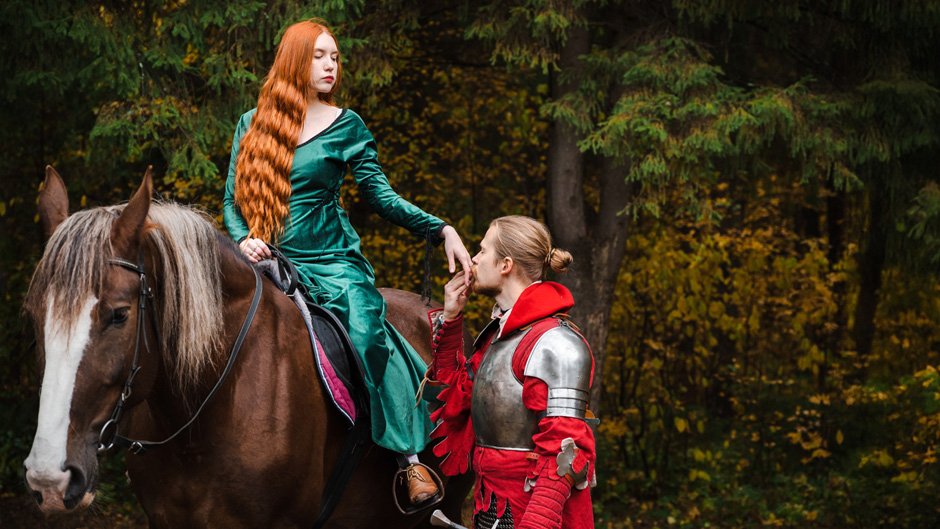Much as popular culture today conveys the “rules” that govern the expression of love, medieval courtly love practices—a combination of attraction and idealization that intertwined erotic desire and spiritual attainment—informed how love was understood and practiced, according to Noa Nikolsky, an assistant professor of English in the University of Miami College of Arts and Sciences.
“Love comes in all flavors, of course, but in the Middle Ages it’s maybe most interesting to talk about ‘courtly love,’ a concept that has seeped into popular discourse,” Nikolsky said. “It’s hard to categorize. Courtly love isn’t a genre like rom-com or a style—it’s more a loose bunch of ideas about love that were popular in literature and poetry. But if we’re talking about romantic love, this was very much on the forefront.”
Nikolsky noted that people of the time didn’t refer to the practices as courtly love; the earliest references were to “fin amor,” which originated in Occitania, a southwestern region in France.
“There was writing about love earlier, of course, but starting from the 12th century, we find a lot of writing about love in literature. It begins in this French tradition and then spreads all over Europe; some say it starts with Troubadour poetry, a kind of song,” explained Nikolsky, a medievalist who works at the intersection of literary studies and the history of medicine.
These were romantic tales about knights and ladies and King Arthur, along with parodies of conventional love tropes. And most were stories about a specific kind of love—aristocratic heterosexual love between a suitor and his lady and usually instigated by the man. These stories surfaced in courtly circles and conformed to customs and deportments in the royal courts, which were big sponsors of poetry at the time.
“But the elements and ideas here are that there is an art to love, and the rules of courtliness speak of love as this big, awe-inspiring, sometimes pathological and scary thing that causes you to suffer,” Nikolsky said.
The declaration of Valentine’s Day took place in 498 C.E. to memorialize one or two 3rd-century Christian martyrs. Yet it was Geoffrey Chaucer’s 699-line, 14th-century dream-vision poem where he suffers the complications of love—“I had what I didn't want and longed for what I wanted”—that paired the two.
“While Valentine’s Day honoring a Christian martyr had been celebrated since the late 5th century, ‘Parliament of Fowls’ is probably the first reference we have tying Valentine’s Day to romantic love. These were two separate things, and then Chaucer connected them in his poem,” Nikolsky explained.
The rules related to love were not dictated by government or the church, though these institutions certainly levied harsh punishments for some behaviors, but instead were seeded through cultural conventions.
“We still have a lot of these ideas about love that we see in popular television, movies, and culture,” Nikolsky said. “The stuff that we see on the screen or that we read about bleeds into our lives. Television constructs these rules of love, rather than it being the other way around—that TV depicts how love is in real life.”
Courtly love was far from the bliss of tempting chocolates, fragrant red roses, and syrupy poetic pledges.
“Love is often difficult or there’s some trouble or impediment to it. One example is a very unequal power dynamic—a very lowly knight and a very wealthy lady—so that’s a big problem,” noted Nikolsky, adding that the stories rarely focused on love between a married couple.
“A lot of romances are primarily about adultery; that’s where the love happens. In fact, marriage has very little to do with courtly love. Romances have these problems that we still have today, like the lady’s father wants to ship her off to marry someone else or the knight gets himself into trouble,” she said.
Nikolsky referred to these as the context or circumstances from which courtly love arises. She added that, while it may be simplistic, some literature exists suggesting that love can be engendered or induced, that it can start through contemplation.
“You can just sit and think and contemplate about love and suddenly feel those kind of feelings—and it’s always men who suffer from this,” she said. “Sometimes it is love at first sight, so they see their objective love and they start contemplating her, her form and her beauty. And then once you have this love, then you suffer from it.”
In terms of the suffering, Nikolsky referenced psychological medicine—a focus of her research—that reveals much about how people at the time viewed or understood love.
“Psychology doesn’t yet exist in the Middle Ages, but we do have a lot of medical writing about love. There are quite a few texts about lovesickness. This was considered a proper medical topic that physicians and natural philosophers could write about,” she said.
Psychology today refers to the condition of “limerence”—an extreme form of unrequited love that causes significant distress.
This condition was very prominent in the Middle Ages and analyzed by many authors who probed its symptoms and pondered its cures. In several of Chaucer’s stories, his characters suffer this distress of lovesickness.
“This was a kind of prestigious male disease, meaning that people could claim, ‘Oh, look how noble I am. I’m so lovesick.’ So again, it kind of bleeds into the culture in this way,” Nikolsky said.

